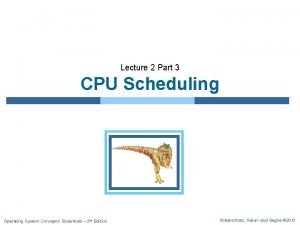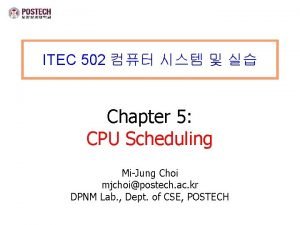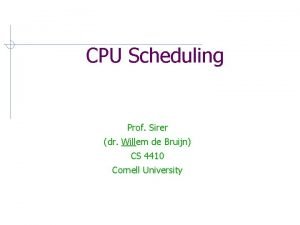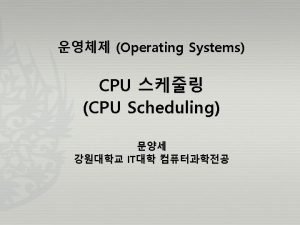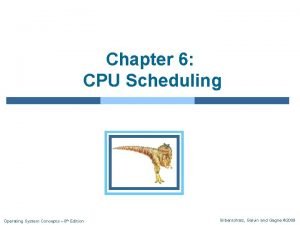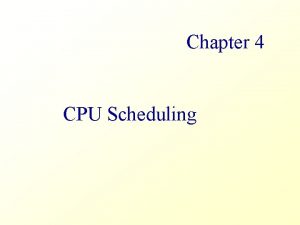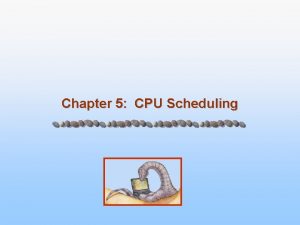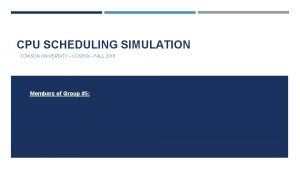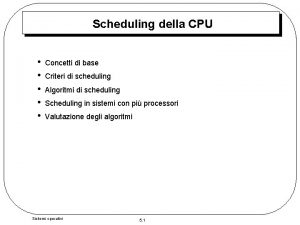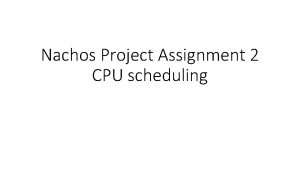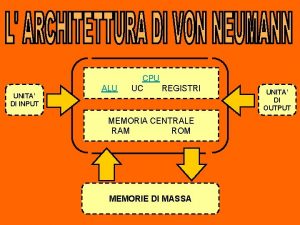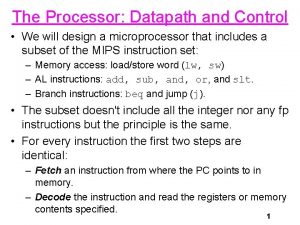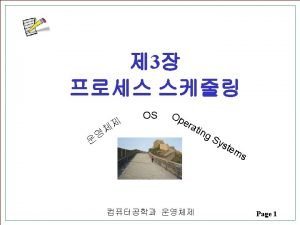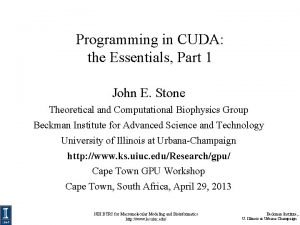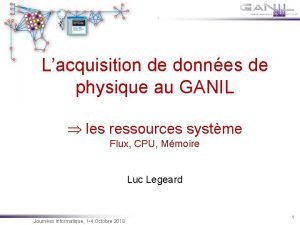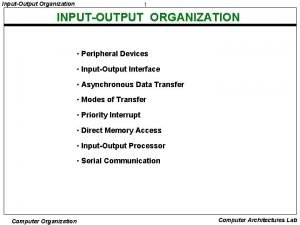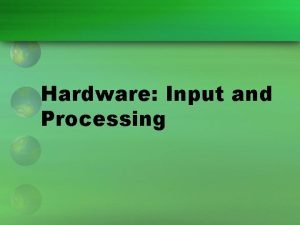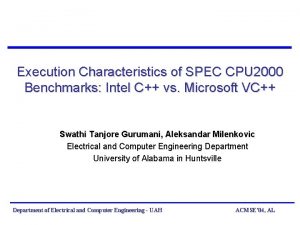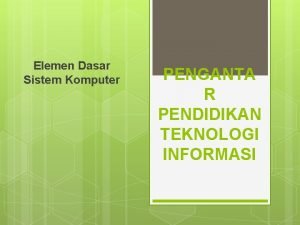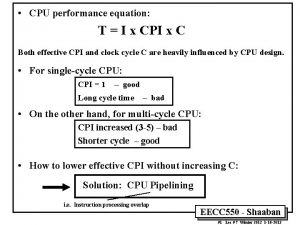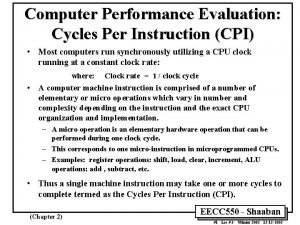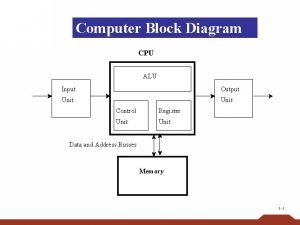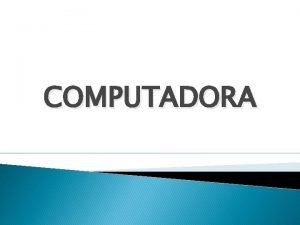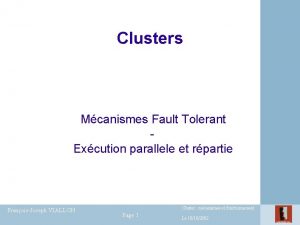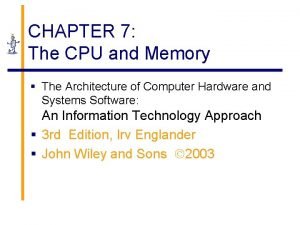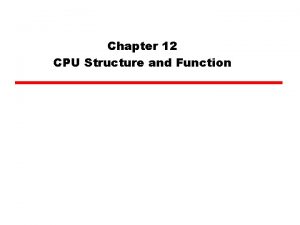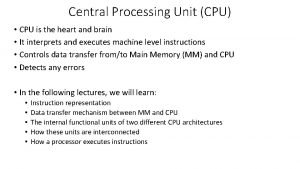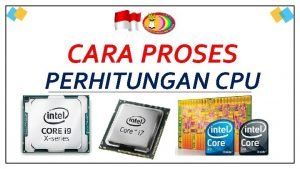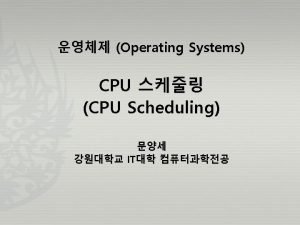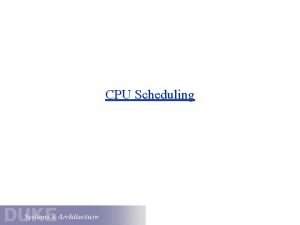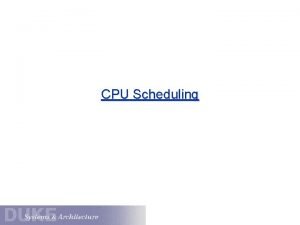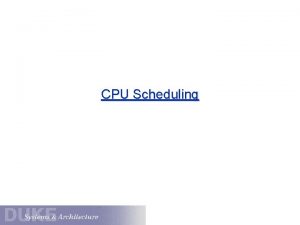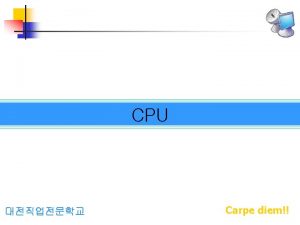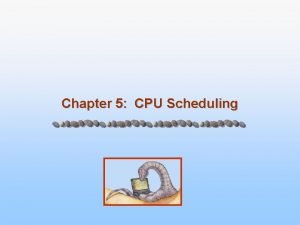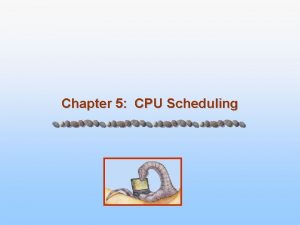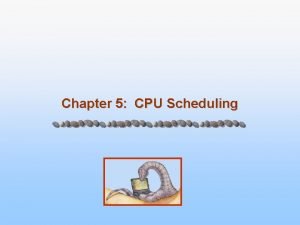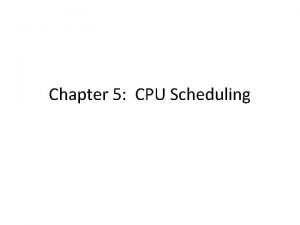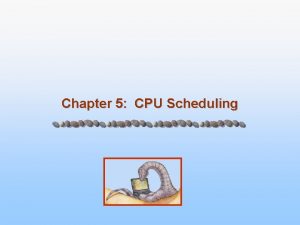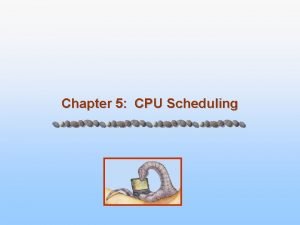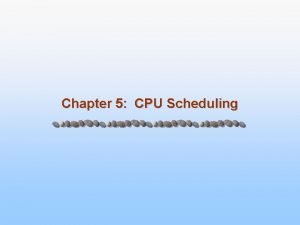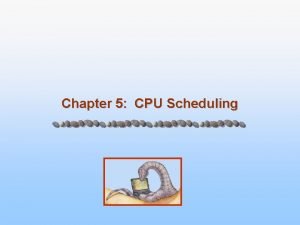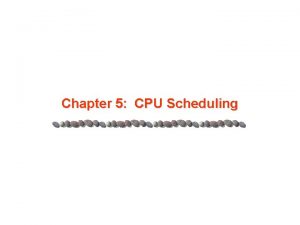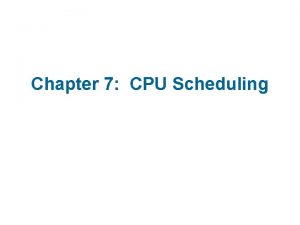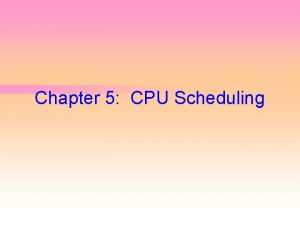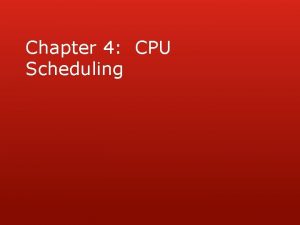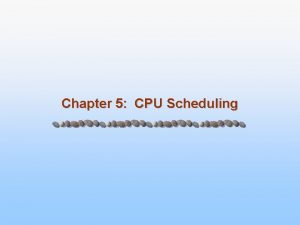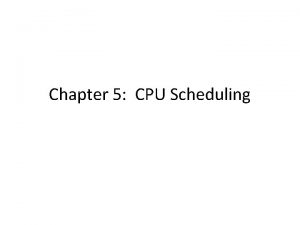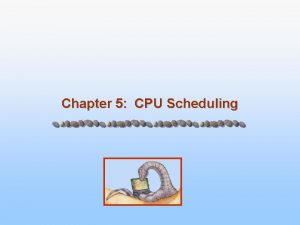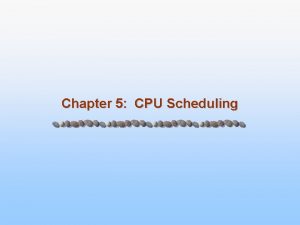Chapter 6 CPU Scheduling Chapter 6 CPU Scheduling













































- Slides: 45

Chapter 6: CPU Scheduling

Chapter 6: CPU Scheduling n Basic Concepts n Scheduling Criteria n Scheduling Algorithms n Thread Scheduling n Multiple-Processor Scheduling n Operating Systems Examples n Algorithm Evaluation 5. 2

Objectives n To introduce CPU scheduling, which is the basis for multiprogrammed operating systems n To describe various CPU-scheduling algorithms n To discuss evaluation criteria for selecting a CPU-scheduling algorithm for a particular system 5. 3

Basic Concepts n Maximum CPU utilization obtained with multiprogramming n CPU–I/O Burst Cycle – Process execution consists of a cycle of CPU execution and I/O wait n CPU burst distribution 5. 4

Histogram of CPU-burst Times 5. 5

Alternating Sequence of CPU and I/O Bursts 5. 6

CPU Scheduler n Selects from among the processes in memory that are ready to execute, and allocates the CPU to one of them n CPU scheduling decisions may take place when a process: 1. Switches from running to waiting state 2. Switches from running to ready state 3. Switches from waiting to ready 4. Terminates n Scheduling under 1 and 4 is non-preemptive n All other scheduling is preemptive – implications for data sharing between threads/processes 5. 7

Dispatcher n Dispatcher module gives control of the CPU to the process selected by the scheduler; this involves: l switching context l switching to user mode l jumping to the proper location in the user program to restart that program n Dispatch latency – time it takes for the dispatcher to stop one process and start another running 5. 8

Scheduling Criteria n CPU utilization – keep the CPU as busy as possible n Throughput – # of processes that complete their execution per time unit n Turnaround time – amount of time to execute a particular process n Waiting time – amount of time a process has been waiting in the ready queue n Response time – amount of time it takes from when a request was submitted until the first response is produced, not output (for 5. 9

Scheduling Algorithm Optimization Criteria n Max CPU utilization n Max throughput n Min turnaround time n Min waiting time n Min response time 5. 10

First-Come, First-Served (FCFS) Scheduling Process Burst Time P 1 24 P 2 3 P 3 3 n Suppose that the processes arrive in the order: P 1 , P 2 , P 3 The Gantt Chart for the schedule is: P 1 P 2 0 24 P 3 27 30 n Waiting time for P 1 = 0; P 2 = 24; P 3 = 27 n Average waiting time: (0 + 24 + 27)/3 = 17 5. 11

FCFS Scheduling (Cont. ) Suppose that the processes arrive in the order: P 2 , P 3 , P 1 n The Gantt chart for the schedule is: P 2 0 P 3 3 P 1 6 30 n Waiting time for P 1 = 6; P 2 = 0; P 3 = 3 n Average waiting time: (6 + 0 + 3)/3 = 3 n Much better than previous case 5. 12

Shortest-Job-First (SJF) Scheduling n Associate with each process the length of its next CPU burst. Use these lengths to schedule the process with the shortest time. n SJF is optimal – gives minimum average waiting time for a given set of processes l The difficulty is knowing the length of the next CPU request. 5. 13

Example of SJF Process Arrival Time Burst Time P 1 0. 0 6 P 2 2. 0 8 P 3 4. 0 7 P 4 5. 0 3 n SJF scheduling chart P 4 0 P 3 P 1 3 9 P 2 16 24 n Average waiting time = (3 + 16 + 9 + 0) / 4 = 7 5. 14

Determining Length of Next CPU Burst n Can only estimate the length n Can be done by using the length of previous CPU bursts, using exponential averaging n+1 = t n + (1 - ) n. 5. 15

Prediction of the Length of the Next CPU Burst 5. 16

Examples of Exponential Averaging n =0 n+1 = n l Recent history does not count. n =1 l n+1 = tn l Only the actual last CPU burst counts. n If we expand the formula, we get: n+1 = tn+(1 - ) tn -1 + … +(1 - )j tn -j + … +(1 - )n +1 0 l n Since both and (1 - ) are less than or equal to 1, each successive term has less weight than its predecessor. 5. 17

Priority Scheduling n A priority number (integer) is associated with each process n The CPU is allocated to the process with the highest priority (smallest integer highest priority) l Preemptive l Non-preemptive n Note that SJF is a priority scheduling where priority is the predicted next CPU burst time n Problem Starvation – low priority processes may never execute n Solution Aging – as time progresses increase the priority of the process 5. 18

Round Robin (RR) n Each process gets a small unit of CPU time (time quantum), usually 10 -100 milliseconds. After this time has elapsed, the process is preempted and added to the end of the ready queue. n We can predict wait time: If there are n processes in the ready queue and the time quantum is q, then each process gets 1/n of the CPU time in chunks of at most q time units at once. No process waits more than (n-1)q time units. n Performance l q large FIFO l q small may hit the context switch wall: q must be large with respect 5. 19 to context switch, otherwise

Example of RR with Time Quantum = 4 Process Burst Time P 1 P 2 P 3 24 3 3 n The Gantt chart is: P 1 0 P 2 4 P 3 7 P 1 10 P 1 14 P 1 18 22 P 1 26 P 1 30 n Typically, higher average turnaround than SJF, but better response 5. 20

Time Quantum and Context Switch Time 5. 21

Turnaround Time Varies With The Time Quantum 5. 22

Multilevel Queue n Ready queue is partitioned into separate queues: l foreground (interactive) l background (batch) n Each queue has its own scheduling algorithm: l foreground – RR l background – FCFS n Scheduling must be done between the queues: l Fixed priority scheduling; (i. e. , serve all from foreground then from background). Possibility of starvation. l Time slice – each queue gets a certain amount of CPU time which it can schedule amongst its processes; i. e. , 80% to foreground in RR l 20% to background in FCFS 5. 23

Multilevel Queue Scheduling 5. 24

Multilevel Feedback Queue n A process can move between the various queues; aging can be implemented this way. n Multilevel-feedback-queue scheduler defined by the following parameters: l number of queues l scheduling algorithms for each queue l method used to determine when to upgrade a process l method used to determine when to demote a process l method used to determine which queue a process will enter when that process needs service 5. 25

Example of Multilevel Feedback Queue n Three queues: l Q 0 – RR with time quantum 8 milliseconds l Q 1 – RR time quantum 16 milliseconds l Q 2 – FCFS n Scheduling l A new job enters queue Q 0 which is served FCFS. When it gains CPU, job receives 8 milliseconds. If it does not finish in 8 milliseconds, job is moved to queue Q 1. l At Q 1 job is again served FCFS and receives 16 additional milliseconds. If it still does not complete, it is preempted and moved to queue Q 2. 5. 26

Multilevel Feedback Queues 5. 27

Thread Scheduling n Distinction between user-level and kernel-level threads n Many-to-one and many-to-many models, thread library schedules user -level threads to run on LWP l Known as process-contention scope (PCS) since scheduling competition is within the process n Kernel thread scheduled onto available CPU is system-contention scope (SCS) – competition among all threads in system 5. 28

Pthread Scheduling n API allows specifying either PCS or SCS during thread creation l PTHREAD SCOPE PROCESS schedules threads using PCS scheduling l PTHREAD SCOPE SYSTEM schedules threads using SCS scheduling. 5. 29

Pthread Scheduling API #include <pthread. h> #include <stdio. h> #define NUM THREADS 5 int main(int argc, char *argv[]) { int i; pthread t tid[NUM THREADS]; pthread attr t attr; /* get the default attributes */ pthread attr init(&attr); /* set the scheduling algorithm to PROCESS or SYSTEM */ pthread attr setscope(&attr, PTHREAD SCOPE SYSTEM); /* set the scheduling policy - FIFO, RT, or OTHER */ pthread attr setschedpolicy(&attr, SCHED OTHER); /* create threads */ for (i = 0; i < NUM THREADS; i++) pthread create(&tid[i], &attr, runner, NULL); 5. 30

Pthread Scheduling API /* now join on each thread */ for (i = 0; i < NUM THREADS; i++) pthread join(tid[i], NULL); } /* Each thread will begin control in this function */ void *runner(void *param) { printf("I am a threadn"); pthread exit(0); } 5. 31

Multiple-Processor Scheduling n CPU scheduling more complex when multiple CPUs are available n Homogeneous processors within a multiprocessor n Asymmetric multiprocessing – only one processor accesses the system data structures, alleviating the need for data sharing n Symmetric multiprocessing (SMP) – each processor is self- scheduling, all processes in common ready queue, or each has its own private queue of ready processes n Processor affinity – process has affinity for processor on which it is currently running l soft affinity l hard affinity 5. 32

NUMA and CPU Scheduling 5. 33

Multicore Processors n Recent trend to place multiple processor cores on same physical chip n Faster and consume less power n Multiple threads per core also growing l Takes advantage of memory stall to make progress on another thread while memory retrieve happens 5. 34

Multithreaded Multicore System 5. 35

Operating System Examples n Solaris scheduling n Windows XP scheduling n Linux scheduling 5. 36

Solaris Dispatch Table 5. 37

Solaris Scheduling 5. 38

Windows XP Priorities 5. 39

Linux Scheduling n Constant order O(1) scheduling time n Two priority ranges: time-sharing and real-time n Real-time range from 0 to 99 and nice value from 100 to 140 n (figure 5. 15) 5. 40

Priorities and Time-slice length 5. 41

List of Tasks Indexed According to Priorities 5. 42

Algorithm Evaluation n Deterministic modeling – takes a particular predetermined workload and defines the performance of each algorithm for that workload n Queueing models n Implementation 5. 43

Evaluation of CPU Schedulers by Simulation 5. 44

End of Chapter 6
 Sjf cpu scheduling
Sjf cpu scheduling Multilevel queue scheduling
Multilevel queue scheduling Sjf cpu scheduling
Sjf cpu scheduling Gantt chart fcfs
Gantt chart fcfs Cpu i/o
Cpu i/o Sjf cpu scheduling
Sjf cpu scheduling Cpu scheduling types
Cpu scheduling types A cpu scheduling algorithm determines an order
A cpu scheduling algorithm determines an order Cpu scheduling project
Cpu scheduling project Scheduling della cpu
Scheduling della cpu Cpu scheduling project
Cpu scheduling project Sjn scheduling
Sjn scheduling Alu uc
Alu uc Datapath
Datapath Cpu vs io
Cpu vs io Partes internas y externas del cpu
Partes internas y externas del cpu 아날로그 디지털
아날로그 디지털 John cuda
John cuda Parte frontal de cpu
Parte frontal de cpu In this scheme cpu execution waits while i/o proceeds.
In this scheme cpu execution waits while i/o proceeds. Function of a microprocessor
Function of a microprocessor Bill buzbee
Bill buzbee Cpu consists of
Cpu consists of Cpu
Cpu Input output processor
Input output processor Kernel: initializing cgroup subsys cpuset
Kernel: initializing cgroup subsys cpuset Maqueta de las partes internas del cpu
Maqueta de las partes internas del cpu The history of cpu
The history of cpu The physical parts of a computer
The physical parts of a computer Hardware input
Hardware input Milisegundos
Milisegundos Cpu 2000
Cpu 2000 Elemen-elemen dasar komputer
Elemen-elemen dasar komputer Oma-dm client high cpu
Oma-dm client high cpu Zentraleinheit cpu
Zentraleinheit cpu Classic cpu performance equation
Classic cpu performance equation Per instruction
Per instruction Third gen computers
Third gen computers Cpu block diagram
Cpu block diagram Definicion de dispositivos mixtos
Definicion de dispositivos mixtos Cpu
Cpu Types of cpu architecture
Types of cpu architecture Cpu structure and function
Cpu structure and function Cpu is the heart of computer
Cpu is the heart of computer How to calculate cpu usage
How to calculate cpu usage Peralatan penyimpanan data diluar memori utama dan cpu
Peralatan penyimpanan data diluar memori utama dan cpu
